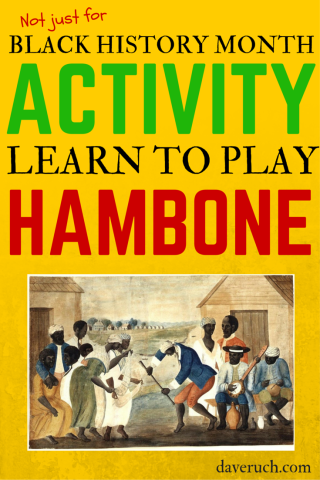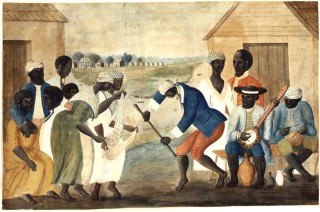 When it comes to fun activities for Black History Month, this one is hard to beat.
When it comes to fun activities for Black History Month, this one is hard to beat.
In fact, I can tell you from firsthand experience that regardless of what month it is, kids of all ages love to learn some hambone.
Whether you’re working with wide-open elementary school kids, or “too cool” middle school students, or earbud-wearing high school seniors (or adults!), they’ll have a great time with this.
What is Hambone?
Hambone, or “pattin’ juba,” is the ancient African and African-American art of making rhythm on the body.
Why?
Well, people don’t always have access to musical instruments, and yet, we all have a need for music. Hambone provides rhythm – – a beat – – for dancing, or singing, or just purely for fun.
Ingenious, really.
Give it a try with your students…
Black History and Hambone
Scholars generally agree that patting juba, or playing “hambone,” has its roots in Africa with traditional drumming and hand clapping used for social dancing.
Because the drum was used as both a method of communication and as a vehicle for communal gathering, dancing. and solidarity (to say nothing of its historic role in some African cultures as a call to war), its use was often restricted by the slave owners once West Africans are brought to the Caribbean and the American colonies. In fact, South Carolina legally banned the use of the drum after a large slave uprising in 1739, and other colonies followed suit.
Many music historians, including the noted scholar of African American folk music Dena J. Epstein, believe that this prohibition contributed to the development of hambone.
It makes sense, doesn’t it? Necessity is the mother of invention, after all.
Numerous 19th century primary sources describe African Americans throughout the American south (Kentucky, Virginia, Georgia, Mississippi, Louisiana, North Carolina) striking their own bodies in various ways to produce rhythmic accompaniment for both music (banjo, fiddle) and dancing.
 (Speaking of the banjo, did you know that this now-iconic symbol of American culture started as an African instrument? It was reimagined here in America with a dried gourd for the body, a long section of wood for the neck, and animal guts for the strings.)
(Speaking of the banjo, did you know that this now-iconic symbol of American culture started as an African instrument? It was reimagined here in America with a dried gourd for the body, a long section of wood for the neck, and animal guts for the strings.)
Hambone All Year Long
I hope you won’t consider this strictly an activity for February any more than American independence is something we celebrate only on July 4, or the spirit of giving is something that’s only important during the winter holidays.
This is North American history, period.
If you’re teaching the Civil War, or the Underground Railroad, or the Early American Republic, or the North American economy, you now have a super-engaging, direct tie-in through this hands-on activity.
And even if none of the above applies to your curriculum, just have fun with this. I hope that you and your students will use it all throughout the year.
BTW, have you seen what actor Morgan Freeman has to say about Black History Month?
More Black History Month Activities and Resources
TeacherVision
Education World
Scholastic
National Education Association
Fact Monster
Edutopia
Please let me know how your “hamboning” is going in the Comments section below!


Well my goodness. I learned violin in an all Black school in Columbus Georgia in the late 60’s and early 70’s and I never quit. I was at first felt insulted about just seeing the use of the word hamboning here on your web site. But seeing and hearing what Morgan Freeman said about Black History Month I can’t agree more. He is absolutely correct. Just continuing the status quo is not right. We must give respect in order to receive it. Pretending that history is not relevant now is also incorrect because we will repeat the same stupidities now. But now I must say Thank you for trying to immerse the History of the most mistreated people of the last few centuries into your curriculum. While I know being a Black Classical Violinist may not be so important to you it may be to the very tiny minorities that may be in most of the schools you go to. Again Thank You.
Thanks for your comments Bertram, and best of luck to you with your music.